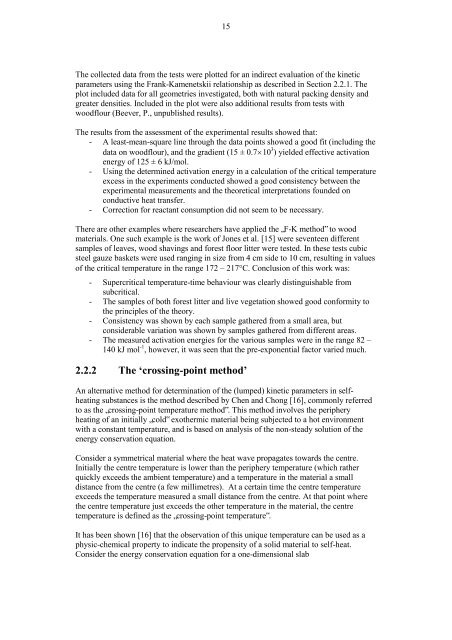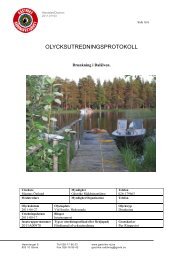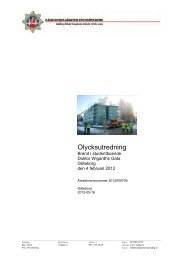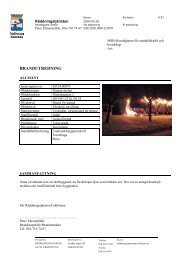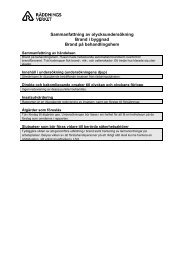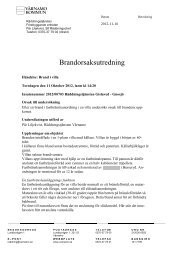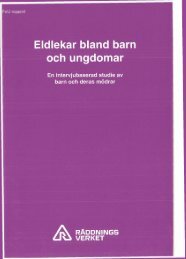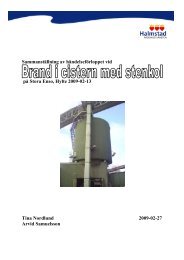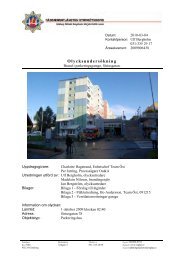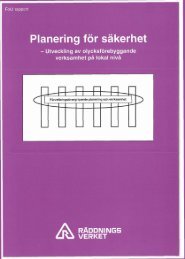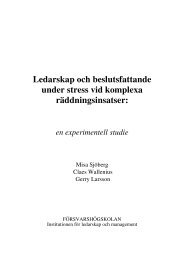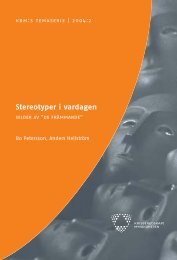Spontaneous Ignition - A Litterature Study of Experimental Methods
Spontaneous Ignition - A Litterature Study of Experimental Methods
Spontaneous Ignition - A Litterature Study of Experimental Methods
You also want an ePaper? Increase the reach of your titles
YUMPU automatically turns print PDFs into web optimized ePapers that Google loves.
15The collected data from the tests were plotted for an indirect evaluation <strong>of</strong> the kineticparameters using the Frank-Kamenetskii relationship as described in Section 2.2.1. Theplot included data for all geometries investigated, both with natural packing density andgreater densities. Included in the plot were also additional results from tests withwoodflour (Beever, P., unpublished results).The results from the assessment <strong>of</strong> the experimental results showed that:- A least-mean-square line through the data points showed a good fit (including thedata on woodflour), and the gradient (15 ± 0.710 3 ) yielded effective activationenergy <strong>of</strong> 125 ± 6 kJ/mol.- Using the determined activation energy in a calculation <strong>of</strong> the critical temperatureexcess in the experiments conducted showed a good consistency between theexperimental measurements and the theoretical interpretations founded onconductive heat transfer.- Correction for reactant consumption did not seem to be necessary.There are other examples where researchers have applied the „F-K method‟ to woodmaterials. One such example is the work <strong>of</strong> Jones et al. [15] were seventeen differentsamples <strong>of</strong> leaves, wood shavings and forest floor litter were tested. In these tests cubicsteel gauze baskets were used ranging in size from 4 cm side to 10 cm, resulting in values<strong>of</strong> the critical temperature in the range 172 – 217C. Conclusion <strong>of</strong> this work was:- Supercritical temperature-time behaviour was clearly distinguishable fromsubcritical.- The samples <strong>of</strong> both forest litter and live vegetation showed good conformity tothe principles <strong>of</strong> the theory.- Consistency was shown by each sample gathered from a small area, butconsiderable variation was shown by samples gathered from different areas.- The measured activation energies for the various samples were in the range 82 –140 kJ mol -1 , however, it was seen that the pre-exponential factor varied much.2.2.2 The ‘crossing-point method’An alternative method for determination <strong>of</strong> the (lumped) kinetic parameters in selfheatingsubstances is the method described by Chen and Chong [16], commonly referredto as the „crossing-point temperature method‟. This method involves the peripheryheating <strong>of</strong> an initially „cold‟ exothermic material being subjected to a hot environmentwith a constant temperature, and is based on analysis <strong>of</strong> the non-steady solution <strong>of</strong> theenergy conservation equation.Consider a symmetrical material where the heat wave propagates towards the centre.Initially the centre temperature is lower than the periphery temperature (which ratherquickly exceeds the ambient temperature) and a temperature in the material a smalldistance from the centre (a few millimetres). At a certain time the centre temperatureexceeds the temperature measured a small distance from the centre. At that point wherethe centre temperature just exceeds the other temperature in the material, the centretemperature is defined as the „crossing-point temperature‟.It has been shown [16] that the observation <strong>of</strong> this unique temperature can be used as aphysic-chemical property to indicate the propensity <strong>of</strong> a solid material to self-heat.Consider the energy conservation equation for a one-dimensional slab


